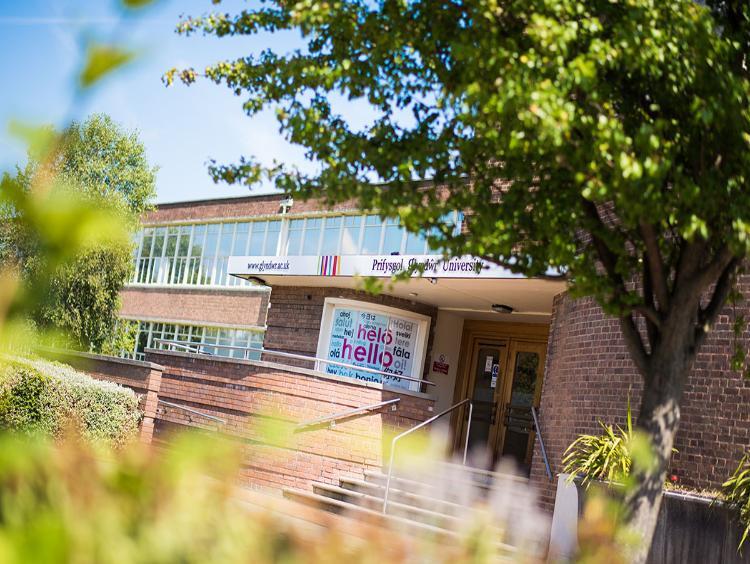CCTV and Body Worn Cameras
Body worn video (BWV) also known as body cameras or body-worn cameras (BWCs), are cameras that are worn by a person. They are usually attached to clothing or an integrated part of a uniform. Images of individuals captured on BWCs are likely to be personal data as defined by data protection legislation, this policy statement outlines the key considerations for using BWCs and is intended to help ensure that the University complies with its obligations under the legislation.
Glyndwr Security Services is committed to maximizing effectiveness in tackling anti-social behavior, reducing crime and disorder and maintaining a safe, secure environment for staff, students and members of the public whilst on University property. In support of this, Body Worn Cameras are being introduced for use by security staff for operational purposes.
Content Accordions
-
PURPOSE AND AIMS
- Prevention/Reduce crime and disorder
- Prevention/Reduce anti-social behaviour
- Provide a safe and secure environment
- Reduce potential escalation of incidents
- Augment opportunities for evidence capture
-
GENERAL PRINCIPLES
BWCs will only be used when operationally necessary in support of the aims outlined above.
Any use of BWC as an operational tool by frontline staff must be justifiable and proportionate to the issue at hand. This means that the use of recording to capture video and audio will be incident specific. For the purposes of this document an ‘incident’ is defined as:
‘An engagement with a person on University property which in the opinion of the Security staff member is confrontational, and where the security officer believes they may be subject to physical or verbal abuse or for the purposes of evidence gathering for a University incident report’.
The security officer is approached by a person on University property in a manner that is perceived as aggressive or threatening
At the commencement of any recording the security officer will, where possible, make a verbal announcement to indicate why recording has been activated and where possible this should include the date, the time and location together with confirmation that the incident is being recorded using video and audio.
The purpose of the announcement is to allow the subject a chance to modify any unacceptable confrontational or aggressive and threatening behaviour, if, at any time during the incident the security officer considers that the use of BWC’s or the issuing of a verbal warning is likely to inflame a confrontational situation the security officer may use discretion to disengage from further discussion and withdraw from the incident. A specific form of words to be used in such circumstances has not been prescribed but security officers should use straightforward speech that can be easily understood by those present such as:
‘I am wearing a body worn CCTV camera and I am now recording video and sound’
If BWCs are used then careful consideration must be given to the use of a comprehensive strategy to comply with ‘fair processing’ of recorded information within the terms of the UK General Data Protection Regulation (UKGDPR) 2018. The basic legal requirement is to comply with the GDPR, however the Security Staff will also consider their obligations in the wider legislative environment with relation to;
Human Rights Act (HRA) 1998,
Freedom of Information Act (FOI) 2000
The Protection of Freedom Act (POFA) 2012 - including Home Office Surveillance Camera Code of Practice pursuant to Section 30 (1)(a) of FOPA 2012.In order to maintain good practice, the Security Staff will use BWCs as advised by the Information Commissioners Office (ICO) Code of Practice for Surveillance Cameras & Personal Information 2014.
Any use of BWCs should be considered alongside prevailing interaction and impact on staff, students or members of the public that may be present.
Standard Operating Procedures (SOPs) that clearly demonstrate acceptable usage of BWC’s will be available to all users (frontline and management) at all levels of recording, data storage and data retrieval.
Security Staff are to comply with this Policy document and SOPs when gathering evidence or information, ensuring the quality and integrity of that evidence or information.
This Policy document and associated SOPs must be followed at any incident where BWCs are or have been used.
Security staff have a BWC evidence third party management system. This system will ensure compliance of all relevant legislation and provide a full audit trial maintaining evidential continuity. Security staff will use the equipment in line with this Policy Statement and SOP’s. They will receive full training and instruction on its use, on-line training on Privacy Impact Awareness and the relevant legislation. Training and the SOP’s shall include;
- How to operate the equipment;
- When to record (and when not to record);
- Other requirements for evidence-gathering;
- Announcing that BWV is in use;
- Downloading footage;
- Maintenance;
- Security;
- Disclosure of images; and
- How to report issues.
All staff will use the equipment in line with Security Service Data Privacy Impact Risk Assessment.
All frontline security staff will have full training before using BWC’s. These staff will receive their own copy of this Policy Statement and SOPs and will confirm their receipt, reading and understanding of these documents after which, they will be authorised to use the equipment.
BWCs archived footage will not routinely be viewed for misdemeanours or unlawful acts committed by users, but if a complaint is received, interrogation of the system is an appropriate line of enquiry and may be instigated.
All requests for reviews may only be actioned on the authority of the Data Protection Officer or the University Solicitor or the Senior Responsible Officer for the University.
The Security Services Data Privacy Impact Risk Assessment will be produced to give guidance on the use of BWCs and associated equipment, this must be used in conjunction with other Generic risk assessments. All trained staff will use the equipment in line with published risk assessments.
Security staff Management will monitor the use of the BWCs to ensure the equipment is an appropriate tool and that its use is in line with this Policy and procedures.
-
DISCLOSURE
Any Disclosures will be consistent with the purpose(s) and aims outlined above. As one of the BWC’s purpose is for the prevention and detection of crime, the University would disclose the images to a law enforcement agency, if appropriate, for example.
Images from BWCs will never be published in the public domain without the authorisation from the Data Protection Officer, the University Solicitor or the Senior Responsible Officer.
All disclosures will be recorded. We will record:
• Who requires access to the footage;
• Why they require access to the footage;
• The disclosure decision (whether granted or refused);
• The date of disclosure; and
• Who made the decision. -
SUBJECT ACCESS REQUESTS
Individuals whose information is recorded have a right to be provided with that information or, if they consent to it, to view that information. These are known as subject access requests (SARs). Please ensure that all SARs are sent to the Data Protection Officer immediately for processing.
-
FOI REQUESTS
The University is subject to the requirements of the Freedom of Information Act 2000 (FOIA). This means that any individual (not necessarily someone whose image is captured) has the right to request access to any recorded information held by the University. All FOIA requests must be sent to the Freedom Information Officer for processing at foi@glyndwr.ac.uk. The timescale for responding to a FOIA request is 20 working days so it is important to make sure that this happens as soon as the request is received.
Section 40 of the FOIA contains a two-part exemption relating to information about individual information. The first part is where the footage contains the image of the person requesting the information. In this case, the request will be refused and the applicant will be advised to submit a SAR. The second part is where the footage contains the image of other people. In such instances, we will be required to balance the interests of the person requesting the information against the rights and freedoms of those whose image is captured.
You should, however, also be aware that we may receive requests about the BWCs system itself, for example, how many units we have, how much they cost, who uses them, etc. If the information is held, we will need to consider whether it would be appropriate to disclose the information. If it is not appropriate to disclose, we will need to determine whether an exemption applies to the information requested and, in certain circumstances, whether the public interest lies in disclosing or withholding the information.
-
RETENTION
The Data Protection Act does not prescribe any specific minimum or maximum retention periods which apply to all systems or footage. It simply states that “Personal data processed for any purpose or purposes shall not be kept for longer than is necessary for that purpose or those purposes”. The BWCs at the University will capture footage for 30 days in order to achieve the purpose(s) for which it is to be used. However, there may be occasions when specific footage is retained for longer, depending, on the incident in question. When specific footage is retained, a case file will be opened securely on the system and will only be retained for the aims and purposes outlined above.
There will be an initial six-monthly review of the system effectiveness to ensure that it is doing what it was intended to do. If the system achieved its purpose, a periodic review (at least annually) of the BWCs will occur and a report submitted to the Information Governance Committee and Audit Committee. If the system does not achieve its purpose, it may be stopped or modified.
The use of BWCs at Glyndwr is overt use; the BWCs are small, however, they are clearly visible. The BWC will not be used in a covert manner, i.e. the cameras will not be hidden.
Complaints regarding the use of BWCs will be directed in the first instance to dpo@glyndwr.ac.uk.
If you have any queries or concerns about these procedures or about the use of BWCs in general, please speak to d.powell@glyndwr.ac.uk, Facilities Manager.
The University has numerous privacy notices to inform data subjects about how we process their personal information. Links to these can be found on the policies and statements page.


